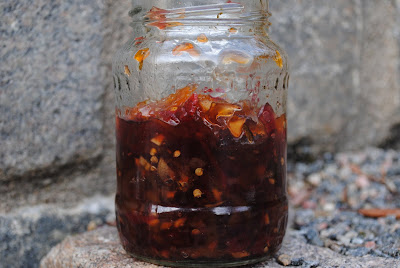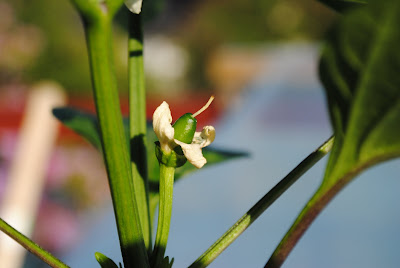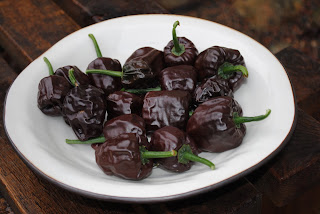
Sunday, November 14, 2010
Making Hot Sauce: Chocolate-Chile Hot Sauce
Making Hot Sauce: Chihluacle Negro Sauce
Tuesday, November 2, 2010
Redder Than Red & Hotter Than Hot
 Indeed, most chile peppers are hot! Peppers are rated based on so-called Scoville Units, a method developed by Wilbur Scoville in 1912. The original method used human tasters to evaluate how many parts of sugar water it takes to neutralize the heat. Nowadays human tasters are spared and a new process called HPLC, or High Performance Liquid Chromotography measures the amount of capsaicinoids (capsaicin) in parts per million. Capsaicin is the compound that gives chiles their heat.(to be continued)
Indeed, most chile peppers are hot! Peppers are rated based on so-called Scoville Units, a method developed by Wilbur Scoville in 1912. The original method used human tasters to evaluate how many parts of sugar water it takes to neutralize the heat. Nowadays human tasters are spared and a new process called HPLC, or High Performance Liquid Chromotography measures the amount of capsaicinoids (capsaicin) in parts per million. Capsaicin is the compound that gives chiles their heat.(to be continued)
Presenting peppers

Below I present the result of my ambition to grow chile peppers. Being the first time ever for me to plant chile in combination with my general lack of knowledge concerning any plants and how to tend them, I must say that it went alright. There were only two or three forms of chile that I didn't manage to grow; the Pequín (which I brought from Mexico), the Jamaica Bell, and the .... Furthermore, while most chiles matured in either august or september, the really hot ones such as the different Habaneros didn't turn red until very late - in late October. These I had to transplant into ceramic containers and move indoors. ( to be continued...)
Chihluacle Negro

Hot Lemon (aka Lemon Drop)

Yellow Adjoema

Unknown chile (from seed bought on a street market in Mexico City)

Hungarian Hot Wax

Orange Habanero

Scotch Bonnet Orange

Scotch Bonnet Chocolate (aka Kongo Black)

Spanish Pepper






Green turns to red
A green pod summer!
Fruit of labour!

Well, look at this! not only do my plants bloom but they also begin to bear fruit! Here's a Chile Fresno seeing its first light of day and this is happening in the middle of June 2010, some three months after it was only a little seed that was put into the soil.


Also, my mum and dad pitched in and gave me a small but functioning greenhouse. And as can be seen below the plants are getting bigger! Maybe I'm on to something here!
The first flower!
The greenhouse effect!


After some thought on how to proceed my new career as a chile grower I decided to construct my own greenhouse. Even if all my plants did not fit in there it sure helped them to get the heat and humidity needed in order to grow, bloom and bear fruits. Some plants I planted right down in the soil in the backyard. Regretfully, however, they never came to bear many fruits. Still more plants were kept in pots inside on the windowsill facing south and others I were given the opportunity by Per and Eva to place in their real greenhouse. Well, all good so far, even though I suspected at this point in time to be a bit late in planting my chile. I was worried that I wouldn't have the opportunity to see my plants bear fruit before the winter was to hit us again!
I wish to thank all those people who helped me with my containers for my plants. I was given a variety of different plastic containers to put my plants in; Mayonnaise-containers from the local Pizzeria Tuppen, Keso-containers from the school's kitchen etc. My neighbor Vivan also gave me a great number of strawberryjam-containers.
Way too many plants for a guy who doesn't even own a greenhouse!

April 2010. Where to place all these plants. In retrospect maybe I should've listened to the woman working in the plantshop: "don't plant too much! You'll not manage it and instead you'll grow tired of it all". Well, at the time I did not own a greenhouse but I had not room for all the plants inside. Therefore, my only option was to place them outside on the porch where they at least had (a partial) roof over their heads. Regretfully, however, The months of April and May, turned out to be a really cold which resulted in that many of the plants grew very very slow. Even so, after a while, I came to the oh so obvious conclusion that I had way too many plants to care for so I called all my friends to come and get what they wanted,
Pepper Permanto in retrospect: Windowsill Germination
 So it continued, me growing chilepepper on my windowsill in march 2010. Besides the seeds from Mexico (which I still do not know what kinds they all are even though I suspect some of them to be Chile de 'Arbol, Guajillo, Cascabel, and Pequín) I planted; Hungarian Hotwax, Hot Lemon (aka Lemon Drop), Spanish Pepper, Piri-Piri, Pasilla, NuMex Joe E. Parker, Anaheim, Fresno, Jalapeño, Red Habanero, Orange Habanero, Rocoto Orange, Scotch Bonnet Red, Scotch Bonnet Orange, Scotch Bonnet Chocolate, Long Yellow Ringo, Serrano Tampiqueño, Yellow Adjoema, Chihluacle Negro, Cayenne Long Slim, Habanero Red Savina, Jamaican Bell, Caribbean Red Habanero, Lombardo, Piment D'espelette, and Apache.
So it continued, me growing chilepepper on my windowsill in march 2010. Besides the seeds from Mexico (which I still do not know what kinds they all are even though I suspect some of them to be Chile de 'Arbol, Guajillo, Cascabel, and Pequín) I planted; Hungarian Hotwax, Hot Lemon (aka Lemon Drop), Spanish Pepper, Piri-Piri, Pasilla, NuMex Joe E. Parker, Anaheim, Fresno, Jalapeño, Red Habanero, Orange Habanero, Rocoto Orange, Scotch Bonnet Red, Scotch Bonnet Orange, Scotch Bonnet Chocolate, Long Yellow Ringo, Serrano Tampiqueño, Yellow Adjoema, Chihluacle Negro, Cayenne Long Slim, Habanero Red Savina, Jamaican Bell, Caribbean Red Habanero, Lombardo, Piment D'espelette, and Apache.In April 2010, roughly one month after first having inserted the seed into the soil (såjord) I found it appropriate to transplant the seedlings and place them in individual larger containers. For this procedure I used Hasselfors P-Jord.
Pepper Permanto Begins: A Retrospective
.JPG)
One may say that it all began in Mexico. In the summer of 2009 I visited Mexico City and just a few days before returning home to Sweden I found myself walking down a crowded streetmarket where I bought several different dried chile pods. While I am still not completely sure what kind of chile I bought ( I am pretty sure of the name of some of them I brought these home and while being insecure of what to do with them I simply put them away on a shelf in a glass jar. Several months later, in March 2010, I somehow got stuck on the idea of planting the seed from the dried pods that I had saved and see what would happen. At the same time I bought more chile seeds from local garden shops as well as from the internet. All in all I planted some 35 different variants of chile which would eventually result in some 300 (!) seeds.
Subscribe to:
Posts (Atom)














